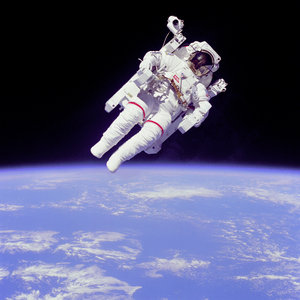Manned space flight began in the US in 1961. Two years earlier, NASA had winnowed down candidates from three U.S. military services to 7 men from the original field of five hundred and eight candidates. Six of these men flew in Project Mercury, completing tests of one-man space capsules from 1961 to 1963. Nine more military men were chosen in 1962 and 14 more in 1963. These men participated in Project Gemini, which tested larger spacecraft from 1965 to 1966. In 1964, it was determined to include scientists as well and from an initial group of over four hundred applicants, 6 scientists were selected for astronaut training in 1965. In 1966, 19 more military men were selected, and in 1967 11 more scientists. The Skylab Missions proved that man could live in space; three separate missions were flown in 1973 and 1974. In 1975, the Apollo-Soyuz Test Project tested docking procedures when two spacecraft were docked nose-to-nose. Starting in 1981, the Space Shuttle flew a large number of successful flights, dramatically increasing man's knowledge of space and leading to the founding of the International Space Station project, which began construction in 2000.
Since the very beginnings of the Space Program, there has been a stringent training regimen for astronauts. There are two kinds of astronauts on missions: pilot astronauts (the vast majority of whom come from either the Air Force or the Navy), and mission specialists (formerly called "scientist astronauts") who are selected based on academic credentials or work experience. Although the requirements differ slightly, they maintain certain standards of physical and mental health. Pilot astronauts have a slightly tougher physical fitness requirement, and must have had at least 1,000 hours of flight time as the pilot in command of a jet aircraft; test pilots receive more consideration than pilots of regular aircraft. All astronaut candidates are required to have at least a bachelor's degree from an accredited institution in physical or biological science, engineering, or mathematics; in addition, mission specialist applicants are required to have at least three years of experience in their field of endeavor. Advanced degrees may substitute for some experience.
Applicants are selected every two years and sent to the Astronaut Candidate Program; civilians may apply at any time to become mission specialists, while military personnel have to apply through their branch of service and be nominated by their service to NASA. From a typical pool of four thousand applicants, NASA accepts 20 into their program.
Once selected, applicants undergo basic training in spacecraft operations as well as taking science classes (geology, meteorology, astronomy, and so forth) and first aid training. They spend a lot of time practicing living in weightless conditions, either in the Neutral Buoyancy Laboratory (which contains large water tanks) or in the zero-g aircraft, the KC-135 (known as the "vomit comet"). After the basic astronaut training, they learn survival and navigation and learn more about shuttle systems. They spend many hours in simulators, practicing various emergency procedures and learning to deal with many different kinds of malfunctions. Throughout the training period, pilot astronauts continue to fly, spending at least 15 hours every month in one of NASA's T-38 jet aircraft. Mission specialists spend at least 4 hours per month in the back seat, learning more about navigation and maintaining communications with the control tower.
In game terms this package adds on to either the Basic Training Package from Dark Champions, or an "Academic" or "Professional" Package from that book or another source.
